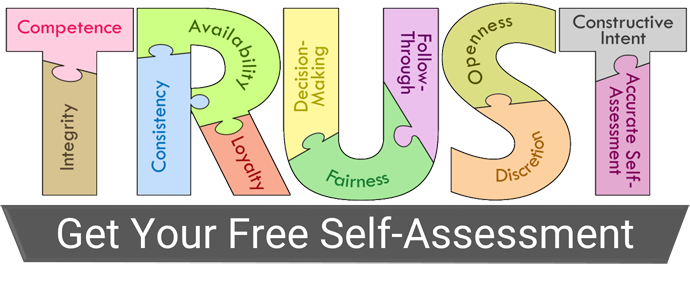Building Trust in the Workplace Starts with This…
When you first meet a new colleague, you have little foundation for trust. Even so, working together effectively requires that you put your faith into the other person. Typically, while we’re building trust for the long term, we rely on one dimension of trust for the short term.
We rely on the other person’s competence. We count on them because they are, presumably, competent in their own are of expertise.
We do this in all sorts of non-workplace transactions, too. We trust ER doctors (complete strangers!) to diagnose and treat injuries and illnesses. We trust plumbers, electricians, hair stylists, mechanics, and experts in every discipline even though we do not know them. When we check their references, we primarily check their credentials and competence.
Building trust takes time. We invest that time in people who make it past that initial screening and prove their competence.
In the workplace, when someone lacks competence, we don’t bother to build trust in the other 11 dimensions. That makes competence a “price of admission” dimension of trust.
The Top Four Most-Admired Characteristics of Leaders Include Two Related to Trust
Thirty years of research by leadership experts Jim Kouzes and Barry Posner reveal the top four, most-admired characteristics of leaders. In ongoing studies, people are asked to select which characteristics are most essential in the leaders they follow and admire.
Not surprisingly, two that rank at the top are related to trust.
1. Honesty consistently tops the list. We examined this dimension of trust in a previous post, starting there because most people immediately associate honesty and integrity with trust. It’s no surprise that we prefer leaders who tell the truth and do not attempt to deceive us.
2. Competence also appears near the top of the list. We want leaders who are capable and will make informed decisions based on their knowledge and abilities.
Both honesty and competence are essential characteristics in leadership. In fact, because these are such vital dimensions of trust, honesty and competence are essential characteristics in any workplace relationship.
In leadership, we also look for people who are inspiring and forward-looking. Though not directly related to trust, these characteristics give us the “why” of our work. We can believe in future vision and be buoyed by it when the people sharing these messages are both honest and competent.
Conversely, if we don’t believe in a leader we won’t believe in their message. The ability to inspire others is gravely diminished if you are not trustworthy. Hyping a future vision when you’ve failed to live up to past promises won’t inspire people. Instead, they’ll think of you as a charlatan and resist changes you hope to implement.
Note: this is not about senior managers. For our purposes, the word “leader” refers to any one at any level who is rallying a group or driving an initiative or championing a cause. You don’t have to be “in charge” to be a leader. In all circles, there are informal leaders who others look to as an example. Typically, the person we look to is someone we view as honest and competent.
Building Trust Takes Time. Competence Precedes Other Dimensions.
People will know whether or not you’re competent before they discover whether or not you’re honest.
Incompetence is difficult to hide for long. In the workplace, others know whether or not you’re competent based on your work output, the questions you ask, the answers you provide, the language you use, the decisions you make, and the priorities you choose. Incompetence is easily exposed.
What’s more, competence is usually demonstrated prior to hiring. Your resume, references, background check, interview, and onboarding screen for competence. That’s why people will start with the assumption that you are, indeed, capable of doing the job or quickly learning how to do it. They will tentatively trust you because of your competence until you violate that trust by displaying incompetence.
Meanwhile, with that fragile and nascent trust in place, you’ll be building trust in other ways (or not!).
For example, while entrusting technical work to you because of your competence, people will be gauging whether or not you are honest and operate with integrity. They’ll make determinations about your trustworthiness based on their interactions with you. This takes time and can’t be rushed.
Keep in mind that there are 10 dimensions of trust that go beyond honest & integrity and competence. We’re covering each of them, one by one, in this CONNECT2Lead series. To assess yourself on the 12 Dimensions of Trust, download this free tool from People First Productivity Solutions.
What to Do When You’re Not Yet Competent
Fake it ‘til you make it is NOT a good strategy for building trust. Pretending to be competent is a surefire way to be seen as dishonest. You’ll impair trust rather than building it if you try to fool others into believing you’re competent when you’re not.
The better option is to acknowledge what you aren’t able to do. Show a willingness to learn and grow. Ask for help and take advice humbly and openly. Don’t make excuses or become defensive. There’s no shame in not knowing how to do everything!
One of the dimensions of trust that we’ll explore in a later post is accurate self-assessment. You’ll be building trust when you openly admit what you don’t know or aren’t entirely competent in doing. The interplay between all 12 dimensions of trust is important to consider. You don’t have to put all your eggs in one basket here!
As you and members of your team continue building, rebuilding, and shoring up trust, use the 12 Dimensions of Trust to open up meaningful dialogue and to support each other. If you’d like to know more about teambuilding workshops, People First Productivity Solutions can help. Email us for more information.

